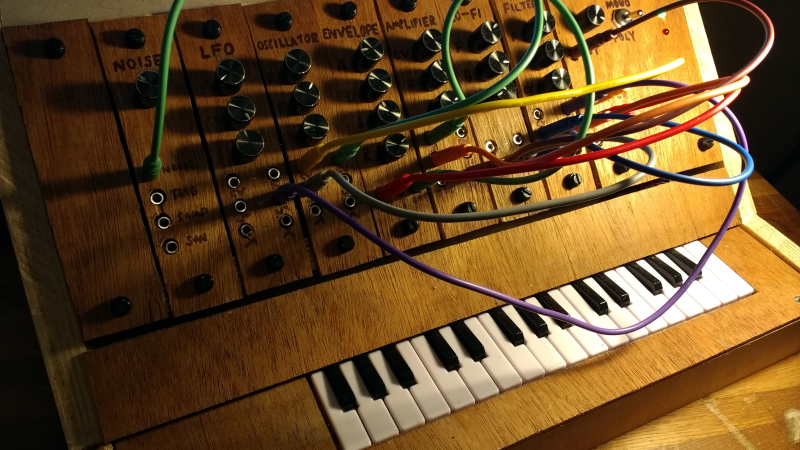[Matt Bradshaw]’s entry in the Hackaday Prize is Polymod, a modular digital synthesizer which combines the modularity of an analog synth with the power of a digital synth. Each module (LFO, Envelope Generator, Amplifier, etc.) are connected with audio cables to others and the result is processed digitally to create music.
The synth is built with a toy keyboard with each key having a tactile switch underneath it, contained inside a wooden case upcycled from a bookshelf found on the street. Each module is a series of potentiometers and I/O jacks with a wooden faceplate. The modules are connected to sockets on the main board and are held in place with thumbscrews so that the modules can be easily switched out. Each module can be connected to others using audio cables, the same way modular analog synths are connected.
The main board contains a Teensy 3.6 and a Teensy Audio Adapter creates the audio for the synth. Software that [Matt] wrote runs on the Teensy and allows the digital synthesizer to run in either monophonic or polyphonic modes. In polyphonic mode, the software creates digital copies of each module to allow the playing of chords. The Teensy scans up to eight module sockets and for each module that it finds, it reads the potentiometer value as well as the status of the I/O jacks. The keyboard buttons are converted to a control voltage which can be sent to any of the modules to create a melody.
[Matt] has created a great synth that combines benefits of both analog and digital synths together and the result is an inexpensive modular synth that can create some really cool sounds. Check out the videos after the break. In the meantime, take a look at this mess of wires and this article on a slew of open-source synthesizers.


















Laaaateeeeeency….
Hi Walter, the latency is actually really low but I appreciate the YouTube video doesn’t really show that! Trying to do multi-track audio with correctly synced video was a bit beyond me video editing capabilities :)
The description above was a bit confusing to me, the hackaday.io page is clearer…the “analog” modules are simply used as inputs to the Teensy and the analog sound is produced digitally entirely within the Teensy (using the inputs from these modules.) Very cool design!
Does the Teensy audio library yet have a resonant lowpass filter with good behavior at high resonance? Last time I played with it, it went chaotic at some settings and was unable to self-oscillate.
Can i ask what sort of cables (& jacks) you used for this?
I have a project going where i need a tonload of cables and i preferably want them to look nice- coloured like these would be amazing.
So far i’ve had little luck, but perhaps you can give me the winning idea :D
They look like mono cables to me- which would make sense.
In itself i know where to get those, but i need around 50 patch cables- and thatd get quite expensive. Or am i doing something horribly wrong here?
I used mono 3.5mm cables for this, mainly because I would then be able to re-use them in an analog modular synth if I ever buy one! The sockets are actually stereo, because they seemed to be a lot cheaper (maybe because they’re more common?). You’re right, though – I’m afraid the cables are one of the most expensive parts of this build! I think they were about £2 each. You could possible get stereo ones for cheaper, especially if you don’t mind plain black ones. I actually could have used breadboard jumper wires for this project, but decided on 3.5mm cables purely for aesthetic reasons. What are you building?
try these:
https://modularaddict.com/eurorack-patch-cables-1221